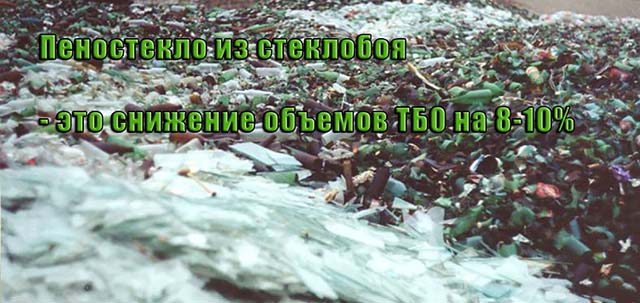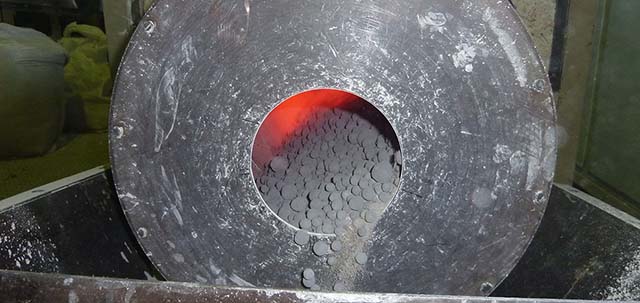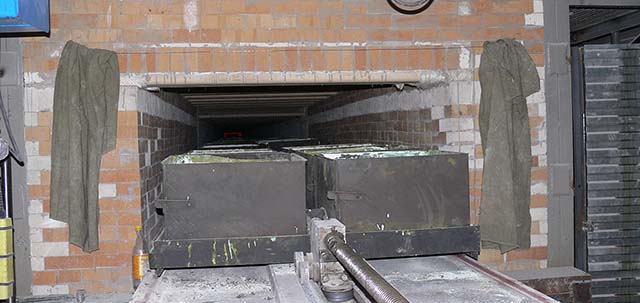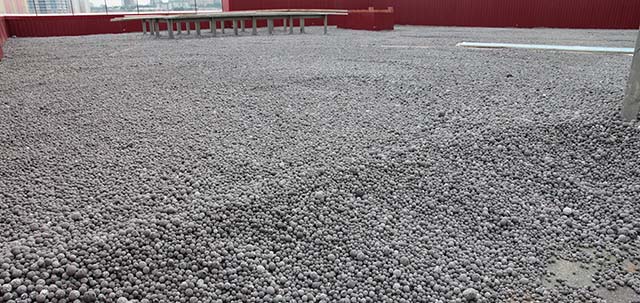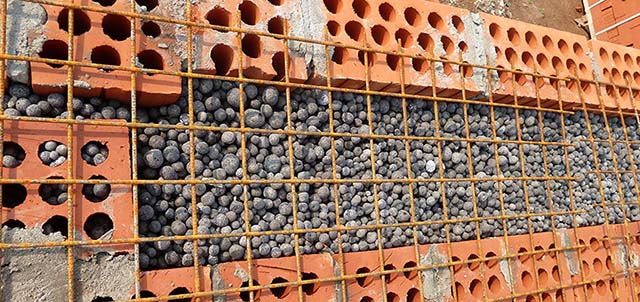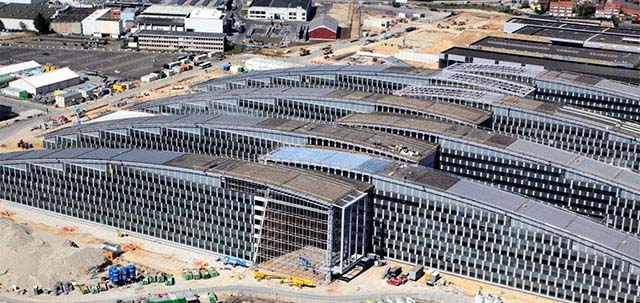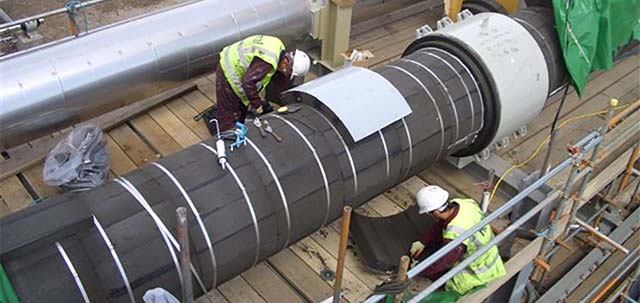A. I. Puzanov
JCS Perm Production of Foamed Silicates
S. I. Puzanov, A. A. Keтоv
Perm State Technical University
Russia
International Conference
University of Dundee 2008
ABSTRACT. Glass cullet as a raw material possesses a number of valuable properties: high strength, chemical stability, availability and a relatively low cost. At present, glass cullet can not be completely utilized, and some part of it (up to 25%) is accumulated in disposal damps that is harmful to the environment. Utilization of glass cullet is a serious problem for municipalities all over the world. The production of artificial silicate materials implies a significant consumption of material and power resources, and mining and processing mineral resources has an unfavorable effect on the environment. Nevertheless, the anthropogenic source of silicate materials – glass cullet – is used in extremely limited quantities. Fine glass cullet is characterized by high ion-exchange activity, especially for Na+ ions. Besides, the amorphous structure of the material implies that a number of chemical and phase reactions proceed on the surface of glass particles. Moreover, silicate glass is characterized by high mechanical strength, so glass powder can be utilized for the production of binding materials and concrete. It was discovered that the glass concrete obtained from a chemically modified glass has higher strength than the concrete from an ordinary glass aggregate. Then, optimum modification conditions were suggested. The obtained results prove that glass can be used as an aggregate for producing concrete with relatively high strength. It was shown that glass as an aggregate can be used, with certain precautions, to manufacture a wide range of concrete and binding materials.
Keywords: Binding materials, Glass cullet utilization, Dispersed glass, Ion-exchange modification.
INTRODUCTION
Glass cullet as a raw material possesses a number of valuable properties: high strength, chemical stability, availability and a relatively low cost. At present, glass cullet cannot be completely utilized, and some part of it (up to 25%) is accumulated in disposal damps, that is harmful for the environment. Utilization of glass cullet is a serious problem for municipalities all over the world.
For example, the U.S. Environmental Protection Agency [1] gives data concerning volumes of unutilized glass accumulated in the environment. The data shows that the volume of annually accumulated glass cullet has stabilized at a value of 12.7 - 13.3 million tons. The volume of utilized glass cullet is about 2.7 - 2.8 million tons annually. So, there is no uptake for about 9.9 - 10.7 million tons of glass cullet, therefore it is land-filled and accumulates in the environment. It should be noted, that the ratio of accumulated and utilized secondary glass does not change. Similar tendency is observed in other countries. For example, according to [2], the volume of annually accumulated glass cullet in Germany has stabilized at the value of 3.4 - 3.6 million tons. About 20 - 25% of annually produced glass accumulates in the environment.
Thus, the quantity of glass stored and discharged to the environment is comparable to the geological resources. The production of artificial silicate materials implies a significant consumption of material and power resources, and mining and processing mineral resources has an unfavorable effect on the environment. Nevertheless, the anthropogenic source of silicate materials – glass cullet – is used in extremely limited quantities.
The recycling of unsorted waste glass poses major problems because glass producers have no easy way for economical reuse. For example, New York City recycling facilities are able to sell plastics and metals, but there are virtually no takers for the glass [3-6]. Some limited applications have been found in asphalt (glasphalt) [7] and roadway fill.
But for the total utilization of glass cullet it is necessary to recycle about tens of million tons of the material annually. We suppose that such volumes of silicate raw materials can be taken up only for the production of building materials. It is usually advised to use glass cullet as an additive, for example, as aggregate for puzzolan concretes or additive in the process of sintering cement clinker.
As a matter of fact, such approach does not utilize specific properties of glass as a material. Besides, introduction of glass aggregate into the composition of concrete induces the reaction between alkalis of the cement and amorphous silica contained in the aggregate, which results in cracking and destruction of the concrete [8-9].
One of the most perspective ways of glass cullet utilization is using it in the production of binding materials [10]. T.R. Jones, R.D. Pascoe and P.B. Hegarty [11] have shown, that such approach is highly effective. They obtained a binding material called ‘casamic’, and the technology of its production is based on the cementing properties of dispersed glass realized in the presence of free Ca2+ ions enabling hardening of the material.
As it was shown earlier [12], dispersed glass acts as a cationic ion-exchanger. This assumption is confirmed by the high pH values of aqueous dispersions of glass powders. Hydrated pastes of the dispersed glass contain highly reactive particles, which can interact with the components of the solution and promote hardening. Thus, dispersed glass can act as a cementing material.So, our purpose was to find out necessary conditions for producing solid concrete-like materials of highly dispersed glass cullet.
RESULTS AND DISCUSSION
Addition of Water Glass
The pH of aqueous dispersions of glass powders is about 8-10. So, amorphous silicon dioxide contained in the structure of glass can be partially dissolved in this solution. The processes of dissolving and precipitation of silicates in dispersed glass pastes may cause formation of condensing silicate phases between glass particles and hardening of the composition. Addition of water glass encourages the process of hardening, for it already contains dissolved silicates, necessary for the formation of new phases between glass particles.
A standard solution of water glass with the density of 1430 kg/m3 and the modulus of 3.2 was taken for the experiments. Glass cullet was ground in a vibro-centrifugal mill to obtain powder with the average particle size of 60 micrometers. In Figure 1, the growth of compressive strength of the obtained material with time is shown.
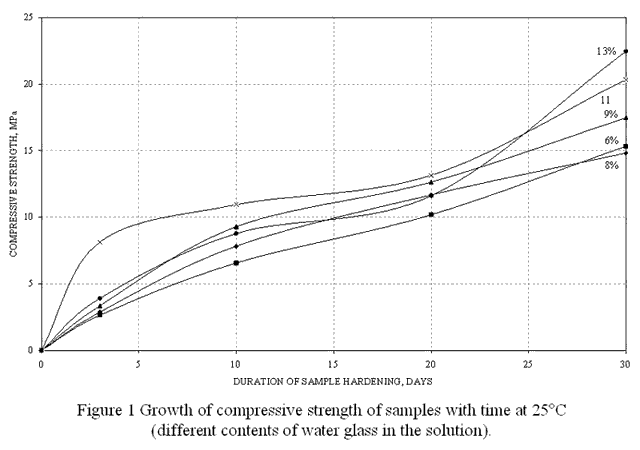
It can be seen that the increasing water glass content improves the compressive strength of the blocks. With the increase of water glass content from 6 to 13%, the compressive strength grows 1.5 times. The maximum compressive strength achieved in 30 days is 22 MPa.
From the technological point of view, it is necessary to accelerate the process of hardening. For this purpose, it is advisable to increase the processing temperature. The necessary experiments have been carried out. The samples were treated for 5 hours at various temperatures. The samples treated at 100-120oC had the maximum compressive strength. Addition of quartz sand also contributed to the growth of sample strength. This probably can be explained by the fact that the excess free alkali causes corrosion of silicon dioxide, contained in quartz, which is then bound with the formation of silicate compounds.
Thus, binding of extra Na+ ions favors the strength of the composite materials. However, it is not recommended to use crystalline quartz for this purpose, for it is rather stable in alkalis. One of the methods of eliminating Na+ ions from the system is a preliminary ion-exchange treatment of glass powder.
Addition of Water Glass into Dispersed Ion-exchange Modified Glass
Dispersed glass is characterized by a high cation-exchange ability, due to the migration of cations (mostly Na+ ions) into the solution. The process can be described with the following scheme:
glass-Na + H2O <--> glass-H + NaOH,
ionic form:
glass-Na + H+ <--> glass-H + Na+,
where glass-Na – is a Na+ ion on the surface of glass attached to the glass matrix able to migrate into the solution. So, dispersed glass can be considered as a non-stoichiometric salt of a weak acid and a strong base. In this case, water acts as a donor of H+ ions, so, the rate of the process can be essentially increased, if we use acid instead of water for the treatment of dispersed glass. Na+ ions can be replaced not only by H+, but also by ions of heavy metals, which form silicates insoluble in water – for example, by ions of Ca.
This process can be described by the following scheme:
2•glass-Na + Ca2+ <--> glass2-Ca + 2•Na+
When dispersed glass is treated by the solutions of acetic acid and calcium chloride, an exchange of Na+ into H+ and Ca2+, respectively, takes place. After this process, the concentration of H+ and Ca2+ ions in the solution decreases, and the concentration of Na+ ions increases. The data obtained are given on Figure 2.
So, dispersed glass is characterized by a high ion-exchange activity. It can be easily transformed into H+ or Ca2+ form, hereinafter called H-glass and Ca-glass.
We have studied the tendencies of hardening the composite materials obtained from the ion-exchange modified glass. The process of hardening was carried out at 25 and 60oC. A solution of water glass was added into the composition as a source of soluble silicates. The results obtained are given in Figure 3.
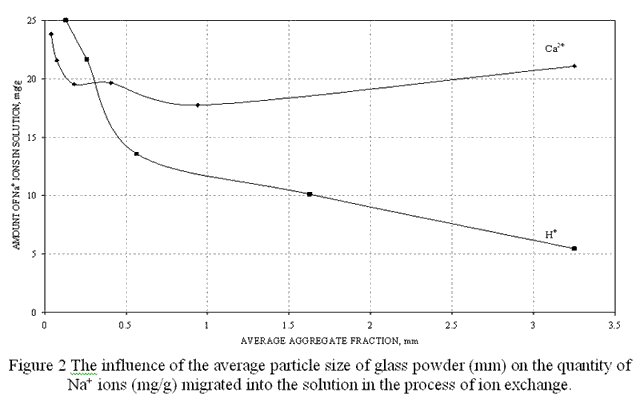
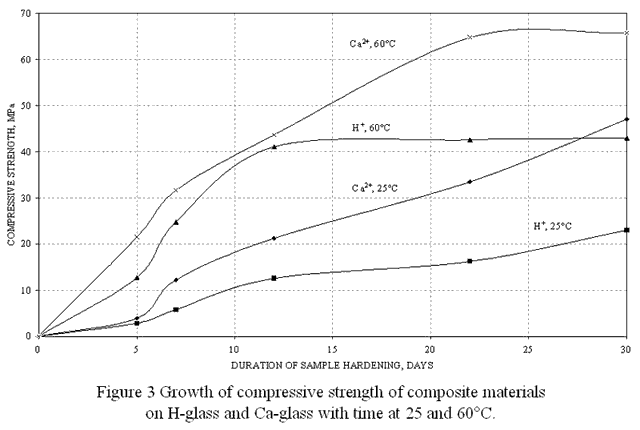
It can be seen, that in four weeks (standard period of time for control concrete strength) the compressive strength of the samples obtained from Ca-glass and H-glass was 21 and 44 MPa, respectively. In 45 days, the compressive strength of the samples obtained from Ca-glass and H-glass was 38 and 74 MPa, respectively. At 60oC, the compressive strength of 21 MPa for Ca-glass is achieved in 6 days, the compressive strength of 44 MPa for H-glass is achieved in 12 days.
So, the obtained composite materials can compete with standard puzzolanic concretes in strength and hardening rate. Besides, the materials can be used for decorative purposes. They are white, and the addition of pigments allows producing the material of any color. Some items, produced according to the suggested technology, are given on Figure 4.
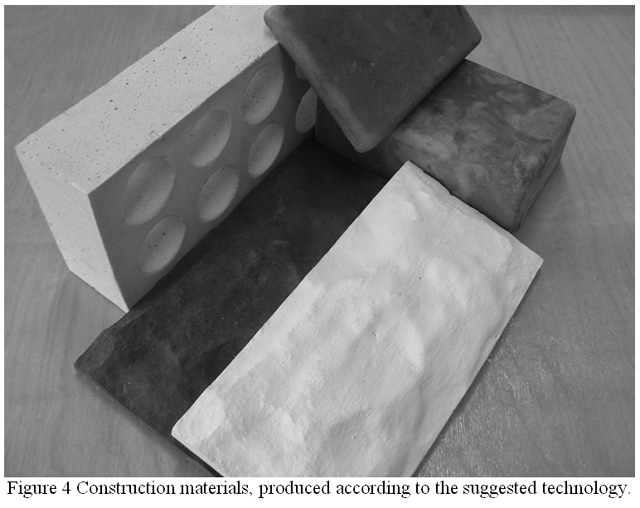
CONCLUSIONS
Dispersed glass possesses cementing properties and can be used for the production of binding materials and concretes. The technology should be based on the cationic ion-exchange activity of the glass surface. The suggested technology allows obtaining glass-containing binding materials, which may harden under various conditions. The obtained concrete-like materials have high strength and good decorative properties. The suggested technology enables us to create new effective binding materials and to utilize glass cullet.
ACKNOWLEDGEMENTS
The authors would like to acknowledge the financial help provided by JCS Perm Production of Foamed Silicates for this project.
REFERENCES:
- UNITED STATES ENVIRONMENTAL PROTECTION AGENCY. Municipal solid waste generation, recycling, and disposal in the United States: Facts and Figures for 2003. Report No. 05-18, Washington, April. 2005.
- GLUSING, A K, CONRADT, R. Dissolution kinetics of impurities in recycled cullet. Recycling and Reuse of glass Cullet: Proceedings of International Symposium 19-20 March 2001, Dundee UK. pp 29-41.
- KIRBY, B. Secondary Markets for Post-Consumer Glass. Resource Recycling, June, 1993.
- TROMBLY, J. Developing Non-Traditional Glass Markets. Resource Recycling, October 1991.
- Glass Feedstock Evaluation Project. Report No. B6 to the Clean Washington Center, Dames and Moore Inc., Seattle, 1993.
- REINDL, J. Development of Non-Traditional Glass Markets. Resource Recycling, October 1991.
- HUGHES, C. S. Feasibility of Using Recycled Glass in Asphalt. Virginia, Transportation Research Council, Charlottesville, Va., Report VTRC 90-R3, March 1990.
- HOBBS, D. W. Alkali-Silica Reaction in Concrete, Thomas Telford, London, 1988.
- SWAMY, R. N. (ed.), The Alkali-Silica Reaction in Concrete, Van Nostrand Reinhold, 1992.
- PATTENGIL, M. Glass as a Pozzolan, Albuquerque Symposium on Utilisation of Waste Glass, Second Prod. 1973
- Jones, T R, Pascoe, R D, Hegarty, P B. A novel ceramic (casamic) made from unwashed glass of mixed colour. Recycling and Reuse of Waste Materials: Proceedings of the International Symposium 9-11 September 2003, Dundee UK. pp 577-585.
- Keтоv, A. Peculiar Chemical and Technological Properties of Glass Cullet as the Raw Material for Foamed Insulation. Recycling and Reuse of Waste Materials: Proceedings of the International Symposium 9-11 September 2003, Dundee UK. pp 695-704.





